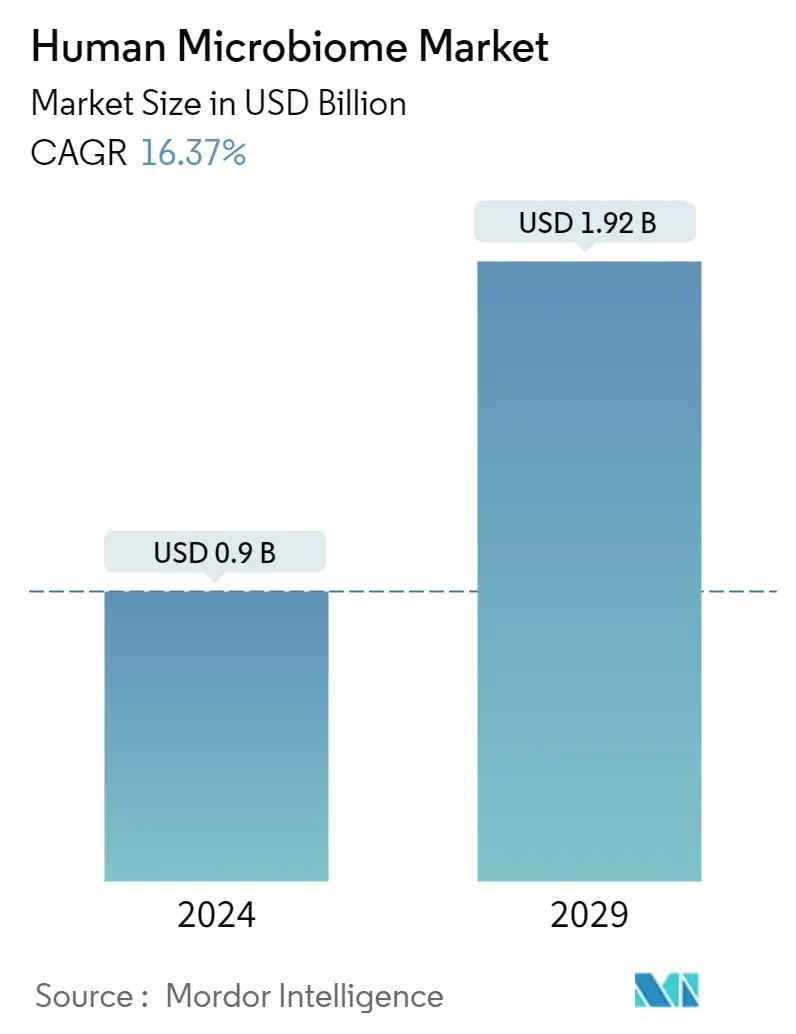Market Size of Human Microbiome Industry

| Study Period | 2019 - 2029 |
| Market Size (2024) | USD 0.90 Billion |
| Market Size (2029) | USD 1.92 Billion |
| CAGR (2024 - 2029) | 16.37 % |
| Fastest Growing Market | Asia-Pacific |
| Largest Market | North America |
Major Players
*Disclaimer: Major Players sorted in no particular order |
Need a report that reflects how COVID-19 has impacted this market and its growth?
Human Microbiome Market Analysis
The Human Microbiome Market size is estimated at USD 0.9 billion in 2024, and is expected to reach USD 1.92 billion by 2029, growing at a CAGR of 16.37% during the forecast period (2024-2029).
The human microbiome has become an area of interest in recent times because of its association with several respiratory diseases and immunity. The gut microbiome has been known to be associated with good immunity. Researchers have reported that variation in the number of microorganisms, such as actinobacteria, firmicute, and Bacteroidetes, leads to the development of lung, respiratory and other disorders. For instance, in April 2020, Persephone Biosciences Inc. started developing an immune-boosting microbiome therapeutic to help prevent and fight the novel coronavirus (SARS-CoV-2) and a potential stool-based diagnostic test designed to help predict which patients are at the highest risk for developing severe complications and mortality after suffering COVID-19. Thus, increasing research studies on the microbiome are the key drivers affirming the growth of this market. The pandemic has created awareness about microbiota therapeutics and diagnosis; thus, the market is expected to follow the same trend even during the post-pandemic period.
Other key factors propelling the growth of this market are the increasing burden of lifestyle-related diseases and the growing geriatric population. For instance, as per the International Diabetes Federation 2021, statistics, there are 52.7 million people aged 20-79 years in Europe having diabetes, and this number is expected to reach 69 million by the year 2045. Increased gut microbial diversity, along with specifically more butyrate-producing bacteria, benefitting insulin resistance and risk of type 2 diabetes, increases the burden of lifestyle diseases such as diabetes, and is expected to drive the growth of the market over the forecast period.
Increasing funding initiatives and government programs to support this research are high-impact rendering drivers anticipated to foster market growth. For instance, as per the National Institute of Health, in May 2022, the Federal Government of the United States incurred USD 864 million on research and development of the microbiome in 2021 and is expected to spend USD 903 million in 2022. Such investment by the government is propelling the growth of the market over the forecast period. However, a lack of comprehensive research and stringent government regulations are likely to limit the market growth over the forecast period.
Human Microbiome Industry Segmentation
As per the scope of the report, the human microbiome is a full array of microorganisms (the microbiota) that live in humans. More specifically, the collection of microbial genomes that contribute to a human's broader genetic portrait, or metagenome. The Human Microbiome Market is segmented by application (Therapeutics and Diagnostics), disease (Obesity, Diabetes, Autoimmune Disorder, Cancer, Gastrointestinal Disorders, Central Nervous System Disorders, and Other Diseases), product (Probiotics, Prebiotics, Symbiotic, and Other Products), and geography (North America, Europe, Asia-Pacific, Middle-East and Africa, and South America). The market report also covers the estimated market sizes and trends for 17 countries across major regions globally. The report offers the value (in USD million) for the above segments.
| By Application | |
| Therapeutics | |
| Diagnostics |
| By Disease | |
| Obesity | |
| Diabetes | |
| Autoimmune Disorders | |
| Cancer | |
| Gastrointestinal Disorders | |
| Central Nervous System Disorders | |
| Other Diseases |
| By Product | |
| Probiotics | |
| Prebiotics | |
| Symboitics | |
| Other Products |
| Geography | ||||||||
| ||||||||
| ||||||||
| ||||||||
| ||||||||
|
Human Microbiome Market Size Summary
The human microbiome market is experiencing significant growth, driven by increasing research and awareness of its role in health and disease. The market is gaining traction due to its association with respiratory diseases and immunity, particularly the gut microbiome's impact on immune function. The COVID-19 pandemic has further accelerated interest in microbiome therapeutics and diagnostics, highlighting their potential in preventing and managing viral infections. The rising prevalence of lifestyle-related diseases and a growing geriatric population are also contributing to market expansion. Government funding and initiatives to support microbiome research are providing additional momentum, although challenges such as regulatory hurdles and limited comprehensive research remain.
North America is currently the leading region in the human microbiome market, supported by a strong drug pipeline and increasing incidences of lifestyle-related and autoimmune disorders. The region's market growth is further bolstered by research studies and regulatory support, with significant investments in investigational new drugs and therapeutics. The market is moderately competitive, with key players like Axial Biotherapeutics, DuPont, Seres Therapeutics, Second Genome, and Synthetic Biologics actively developing new products and therapies. These companies are focusing on enhancing their therapeutics pipeline to offer efficient and safe microbiome-based treatments, which are expected to drive market growth over the forecast period.
Human Microbiome Market Size - Table of Contents
-
1. MARKET DYNAMICS
-
1.1 Market Overview
-
1.2 Market Drivers
-
1.2.1 Increasing Incidence of Lifestyle-related Diseases
-
1.2.2 Growing Geriatric Population
-
-
1.3 Market Restraints
-
1.3.1 Lack of Comprehensive Research
-
1.3.2 Stringent Government Regulations
-
-
1.4 Porter's Five Forces Analysis
-
1.4.1 Threat of New Entrants
-
1.4.2 Bargaining Power of Buyers/Consumers
-
1.4.3 Bargaining Power of Suppliers
-
1.4.4 Threat of Substitute Products
-
1.4.5 Intensity of Competitive Rivalry
-
-
-
2. MARKET SEGMENTATION (Market Size by Value - USD Million)
-
2.1 By Application
-
2.1.1 Therapeutics
-
2.1.2 Diagnostics
-
-
2.2 By Disease
-
2.2.1 Obesity
-
2.2.2 Diabetes
-
2.2.3 Autoimmune Disorders
-
2.2.4 Cancer
-
2.2.5 Gastrointestinal Disorders
-
2.2.6 Central Nervous System Disorders
-
2.2.7 Other Diseases
-
-
2.3 By Product
-
2.3.1 Probiotics
-
2.3.2 Prebiotics
-
2.3.3 Symboitics
-
2.3.4 Other Products
-
-
2.4 Geography
-
2.4.1 North America
-
2.4.1.1 United States
-
2.4.1.2 Canada
-
2.4.1.3 Mexico
-
-
2.4.2 Europe
-
2.4.2.1 Germany
-
2.4.2.2 United Kingdom
-
2.4.2.3 France
-
2.4.2.4 Italy
-
2.4.2.5 Spain
-
2.4.2.6 Rest of Europe
-
-
2.4.3 Asia-Pacific
-
2.4.3.1 China
-
2.4.3.2 Japan
-
2.4.3.3 India
-
2.4.3.4 Australia
-
2.4.3.5 South Korea
-
2.4.3.6 Rest of Asia-Pacific
-
-
2.4.4 Middle East and Africa
-
2.4.4.1 GCC
-
2.4.4.2 South Africa
-
2.4.4.3 Rest of Middle East and Africa
-
-
2.4.5 South America
-
2.4.5.1 Brazil
-
2.4.5.2 Argentina
-
2.4.5.3 Rest of South America
-
-
-
Human Microbiome Market Size FAQs
How big is the Human Microbiome Market?
The Human Microbiome Market size is expected to reach USD 0.90 billion in 2024 and grow at a CAGR of 16.37% to reach USD 1.92 billion by 2029.
What is the current Human Microbiome Market size?
In 2024, the Human Microbiome Market size is expected to reach USD 0.90 billion.

